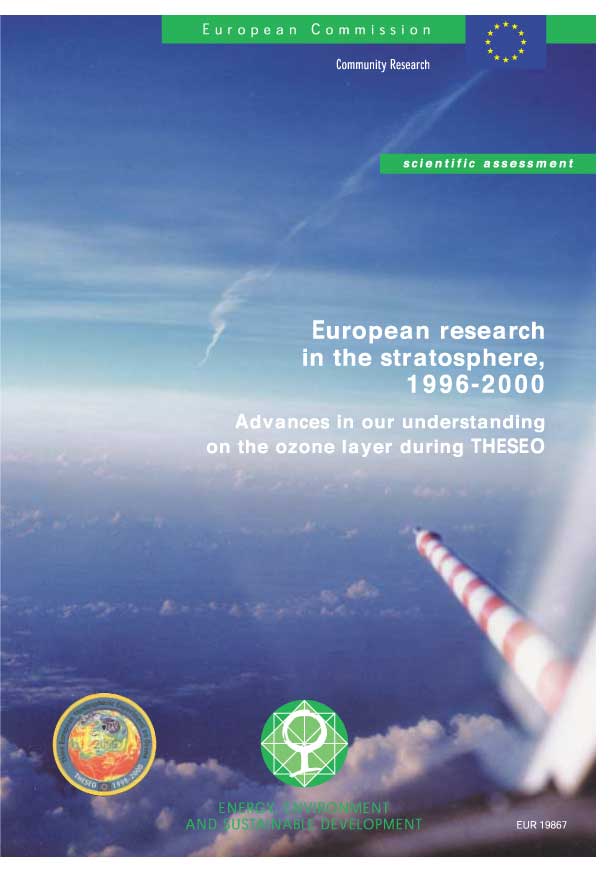 |
Stratospheric Processes And their Role in Climate
|
||||||||
| Home | Initiatives | Organisation | Publications | Meetings | Acronyms and Abbreviations | Useful Links |
![]()
 |
Stratospheric Processes And their Role in Climate
|
||||||||
| Home | Initiatives | Organisation | Publications | Meetings | Acronyms and Abbreviations | Useful Links |
![]()
N.R.P. Harris, EORCU, University of Cambridge, UK (Neil.Harris@ozone-sec.ch.cam.ac.uk)
G.T. Amanatidis, European Commission, DG Research, Belgium (georgios.amanatidis@cec.eu.int)
| An assessment of European research on
stratospheric ozone and UV radiation [1] has recently been published by the European Commission (EC) (see figure 1). It contains a thorough review
of the progress of the European research programme on stratospheric ozone and UV radiation between 1996 and 2000 and assesses the contribution
of European research to the current state of knowledge. It thus highlights the major achievements of the co-ordinated EC and nationally funded research programmes.
The results from the Third European Stratospheric Experiment on Ozone (THESEO), a major part of European stratospheric research in this period, feature strongly. It is hoped that this document will be a valuable resource for scientists working on the stratosphere and particularly for the preparation of the 2002 WMO-UNEP Ozone Assessment. It has taken over 100 scientists almost two years to prepare this assessment and it was subject to peer review by an international
group of scientists. A similar assessment for the period 1989-95 was published in 1997 [2]. |
 |
| (Please contact the SPARC Office, for a better resolution of the image) | Figure 1 : The contrail of the Geophysica aircraft flying at 17 km altitude seen from the DLR Falcon aircraft (at 12 km) on the way to the tropical cyclone Davina on 9 March 1999 during the APE-THESEO experiment. Bands of thin cirrus clouds are visible, belonging to the extended spiral arms of the cyclone. The two aircraft fly in tandem, with the Falcon acting as a pathfinder (by using its aerosol lidar) to steer the Geophysica into ultrathin tropopause clouds which were invisible to the Geophysica pilot. |
The structure of the report is 'issue oriented’ so that the main scientific advance are presented with reference to the overall stratospheric ozone problem. The chapter titles and lead authors are
| 1. Introduction | G. Mégie and G.T. Amanatidis |
| 2. Long term changes | M. Van Roozendael and G. Vaughan |
| 3. Polar ozone | K.S. Carslaw and H. Oelhaf |
| 4. Mid-latitude and tropical ozone | A. Hauchecorne and Th. Peter |
| 5. Stratospheric ozone and the link to climate change | J. Austin and U. Langematz |
| 6. Atmospheric UV radiation | M. Blumthaler and P. Taalas |
| 7. Aviation impact on atmospheric composition and climate | U. Schumann and J. Ström |
The main findings are contained in an executive summary and these in turn are summarised:
Anyone interested in obtaining a copy should contact G.T. Amanatidis, EC DG Research, Rue de la Loi 200, B-1049 Brussels, Belgium;
fax: 32 2 296 3024; email: georgios.amanatidis@cec.eu.int
[1] European Research in the Stratosphere, 1996-2000: Advances in our understanding of the ozone layer during THESEO, eds. G.T. Amanatidis
and N.R.P. Harris, European Commission, EUR 19867, 2001.
[2] European Research in the Stratosphere – The contribution of EASOE and SESAME to our current understanding of the ozone layer, European Commission, EUR 16986, 1997.
![]()